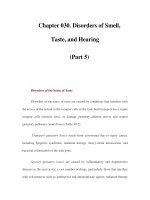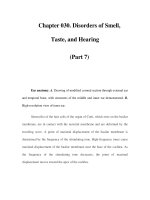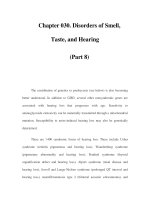Chapter 030. Disorders of Smell, Taste, and Hearing (Part 3) pdf
Bạn đang xem bản rút gọn của tài liệu. Xem và tải ngay bản đầy đủ của tài liệu tại đây (12.39 KB, 5 trang )
Chapter 030. Disorders of Smell,
Taste, and Hearing
(Part 3)
Approach to the Patient: Disorders of the Sense of Smell
Unilateral anosmia is rarely a complaint and is only recognized by testing
of smell in each nasal cavity separately. Bilateral anosmia, on the other hand,
brings patients to medical attention. Anosmic patients usually complain of a loss
of the sense of taste even though their taste thresholds may be within normal
limits. In actuality, they are complaining of a loss of flavor detection, which is
mainly an olfactory function. The physical examination should include a thorough
inspection of the ears, upper respiratory tract, and head and neck. A neurologic
examination emphasizing the cranial nerves and cerebellar and sensorimotor
function is essential. Any signs of depression should be noted.
Sensory olfactory function can be assessed by several methods. The Odor
Stix test uses a commercially available odor-producing magic marker–like pen
held approximately 8–15 cm (3–6 in.) from the patient's nose. The 30-cm alcohol
test uses a freshly opened isopropyl alcohol packet held ~30 cm (12 in.) from the
patient's nose. There is a commercially available scratch-and-sniff card containing
three odors available for gross testing of olfaction. A superior test is the University
of Pennsylvania Smell Identification Test (UPSIT). This consists of a 40-item,
forced choice, scratch-and-sniff paradigm. For example, one of the items reads,
"This odor smells most like (a) chocolate, (b) banana, (c) onion, or (d) fruit
punch." The test is highly reliable, is sensitive to age and sex differences, and
provides an accurate quantitative determination of the olfactory deficit. The
UPSIT, which is a forced-choice test, can also be used to identify malingerers who
typically report fewer correct responses than would be expected by chance. The
average score for total anosmics is slightly higher than that expected on the basis
of chance because of the inclusion of some odorants that act by trigeminal
stimulation.
Olfactory threshold testing is another method of assessing olfactory
function. Following assessment of sensory olfactory function, the detection
threshold for an odorant such as methyl ethyl carbinol is established using
graduated concentrations for each side of the nose. Nasal resistance can also be
measured with anterior rhinomanometry for each side of the nose.
CT or MRI of the head is required to rule out paranasal sinusitis; neoplasms
of the anterior cranial fossa, nasal cavity, or paranasal sinuses; or unsuspected
fractures of the anterior cranial fossa. Bone abnormalities are best seen with CT.
MRI is the most sensitive method to visualize olfactory bulbs, ventricles, and
other soft tissue of the brain. Coronal CT is optimal for assessing cribriform plate,
anterior cranial fossa, and sinus anatomy.
Biopsy of the olfactory epithelium is possible. However, given the
widespread degeneration of the olfactory epithelium and intercalation of
respiratory epithelium in the olfactory area of adults with no apparent olfactory
dysfunction, biopsy results must be interpreted with caution.
Disorders of the Sense of Smell: Treatment
Therapy for patients with transport olfactory losses due to allergic rhinitis,
bacterial rhinitis and sinusitis, polyps, neoplasms, and structural abnormalities of
the nasal cavities can be undertaken with a high likelihood for improvement.
Allergy management; antibiotic therapy; topical and systemic glucocorticoid
therapy; and surgery for nasal polyps, deviation of the nasal septum, and chronic
hyperplastic sinusitis are frequently effective in restoring the sense of smell.
There is no proven treatment for sensorineural olfactory losses.
Fortunately, spontaneous recovery often occurs. Zinc and vitamin therapy
(especially with vitamin A) are advocated by some. Profound zinc deficiency can
produce loss and distortion of the sense of smell but is not a clinically important
problem except in very limited geographic areas (Chap. 71). The epithelial
degeneration associated with vitamin A deficiency can cause anosmia, but in
western societies the prevalence of vitamin A deficiency is low. Exposure to
cigarette smoke and other airborne toxic chemicals can cause metaplasia of the
olfactory epithelium, and spontaneous recovery can occur if the insult is removed.
Counseling of patients is therefore helpful in such cases.
More than half of people over age 60 suffer from olfactory dysfunction. No
effective treatment exists for presbyosmia, but patients are often reassured to learn
that this problem is common in their age group. In addition, early recognition and
counseling can help patients to compensate for the loss of smell. The incidence of
natural gas–related accidents is disproportionately high in the elderly, perhaps due
in part to the gradual loss of smell. Mercaptan, the pungent odor in natural gas, is
an olfactory stimulant that does not activate taste receptors. Many elderly with
olfactory dysfunction experience a decrease in flavor sensation and find it
necessary to hyperflavor food, usually by increasing the amount of salt in their
diet.
Taste
Compared with disorders of smell, gustatory disorders are uncommon. Loss
of olfactory sensitivity is often accompanied by complaints of loss of the sense of
taste, usually with normal detection thresholds for taste.









